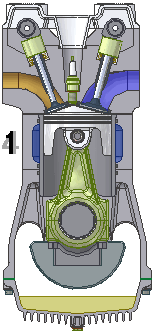
Now you should know what the parts are. If you don’t, please read previous post coz in this post we going to tell you how they work. Well, actually there are many types of engine but we would like to remind you once again that our goal to set this blog up is to share about Honda and Toyota valve technology which we will be focus on Variable Valve Timing and Lift Electronic Control (VTEC) and Variable Valve Timing (VVT). So in order to perform these tasks, we should explain few parts that may involve. So, in this post we will get through four stoke. In this post, we aim that you will understand when does the valves open and close. It’s not going to be very detail about how since we planned to do that on the next post.The operating cycle of an internal combustion engine can be broken down into a sequence of separate processes: intake, compression, combustion, expansion, and exhaust.Let’s get into the idea on how internal combustion four stroke cycle engine work.
1 – Intake stroke, Induction stroke
Inlet valve open : exhaust valve closed
The momentum imparted to the flywheel during previous cycles or external forces causes the connecting rod to draw the piston outwards, setting up a partial vacuum which sucks in a new charge of combustible mixture from the carburetor. The pressure will be below atmospheric pressure by an amount which depends upon the speed of the engine and the throttle valve opening. The inlet valve communicates through a throttle valve with the carburetor or vaporiser, from which a combustible mixture of fuel and air is drawn. The exhaust valve communicates with the silencer through which the burnt gases are discharged to the atmosphere. These valves are opened and closed at suitable intervals by mechanisms.
2 – Compression stroke
Inlet valve closed : exhaust valve closed The compression stroke start when the piston at bottom dead center (BDC) and both valve closed. The piston still driven by the momentum of flywheel compressed the fuel mixture into the head of the cylinder. The pressure rises to an amount which depends on the compression ratio, that is, the ratio of full volume of the cylinder when the piston at the outer end of its stroke to the volume of the clearance space when the piston is at the inner or upper end of its stroke.
The compression stroke start when the piston at bottom dead center (BDC) and both valve closed. The piston still driven by the momentum of flywheel compressed the fuel mixture into the head of the cylinder. The pressure rises to an amount which depends on the compression ratio, that is, the ratio of full volume of the cylinder when the piston at the outer end of its stroke to the volume of the clearance space when the piston is at the inner or upper end of its stroke.
3 – Combustion or working stroke
Inlet valve closed : exhaust valve closed
Expansion “power” stroke, which start when the piston at top dead center (TDC) and both valves are closed an ends when the piston at BDC as the high pressure, high temperature gases push the piston down and force the crank to rotate. Just before the end of the compression stroke, ignition of the charge is effected by means of an electric spark, and a rapid rise of temperature and pressure occurs inside the cylinder. Combustion is completed while the piston is practically at rest, and is followed by the expansion of the hot gases as the piston moves outwards. The pressure of the gases drives the piston forward and turns the crankshaft thus propelling the car against the external resistances and restoring to the flywheel the momentum lost during the idle strokes. The pressure falls as the volume increases.
4 – Exhaust stroke
Inlet valve closed : exhaust valve openIt begin to start when the exhaust valve opens and end when the piston reach the TDC where the Exhaust port close and the intake port open to repeat the cycle. The piston returns, again driven by the momentum of the flywheel, and discharges the spent gases through the exhaust valve. The pressure will be slightly above atmospheric pressure by an amount depending on the resistance to flow offered by the exhaust valve and silencer. It will thus be seen that there is only one working stroke for every four piston strokes, or every two revolutions of the crankshaft, the remaining three strokes being referred to as idle strokes, though they form an indispensable part of the cycle.
So in the cycle, these four strokes will be look like this.




No comments:
Post a Comment